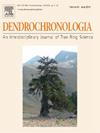Aspects of different growth responses of coniferous and broadleaved tree species in landslide research
IF 2.7
3区 农林科学
Q1 FORESTRY
引用次数: 0
Abstract
This study investigates the differing responses of two tree species, P. abies and F. sylvatica, to landslide movements and their subsequent effects on landslide chronologies. These are the two most commonly used tree species in dendrogeomorphic landslide research in Central Europe and their combination is generally recommended. However, their specific effect on the resulting chronology is not yet taken into account although they are two quite different species. The research was conducted on 220 individuals of both species located in the Girová landslide area (Outer Western Carpathians), with a focus on the catastrophic event of May 2010. The study sought to understand how these species contribute to dendrogeomorphic reconstructions of landslide events, particularly by analyzing their growth responses and the frequency of growth disturbances (GDs) such as compression and tension wood. The results revealed significant differences in how P. abies and F. sylvatica responded to landslide activity. P. abies showed a higher frequency of GDs (compression wood), but exhibited greater inertia in its physiological response, potentially masking high-frequency landslide events. In contrast, F. sylvatica produced fewer GDs (tension wood), yet its response to landslides was more immediate and efficient, with 100 % intensity in tension wood formation, which helped create a minimum-noise chronology despite fewer identified events. The study highlights the advantages and limitations of both species in dendrogeomorphic research. While P. abies contributes more frequently to detecting landslide events, the inertia in compression wood formation can complicate the interpretation of rapid landslide movements. On the other hand, F. sylvatica, though less responsive in terms of GDs, provides a clearer and more precise landslide chronology. Future research should explore the physiological factors behind these species' different responses to enhance the accuracy of dendrogeomorphic reconstructions.
滑坡研究中针叶树和阔叶树不同生长响应的方面
本研究探讨了两种树种杉木和冷杉对滑坡运动的不同反应及其对滑坡年代学的影响。这是中欧地区树木地貌滑坡研究中最常用的两种树种,一般建议将它们组合使用。然而,尽管它们是两个完全不同的物种,但它们对由此产生的年表的具体影响尚未考虑在内。该研究对位于girov滑坡区(喀尔巴阡山脉外西部)的这两个物种的220只个体进行了研究,重点关注2010年5月的灾难性事件。该研究试图了解这些物种如何有助于滑坡事件的树木地貌重建,特别是通过分析它们的生长响应和生长干扰(GDs)的频率,如压缩和拉伸木材。结果表明,冷杉和森林杉对滑坡活动的响应存在显著差异。冷杉表现出更高的GDs(压缩木)频率,但在生理反应中表现出更大的惯性,可能掩盖了高频滑坡事件。相比之下,F. sylvatica产生较少的GDs(张力木),但它对滑坡的反应更直接和有效,张力木形成的强度为100% %,这有助于创建最小噪音年表,尽管确定的事件较少。该研究突出了这两个物种在树木地貌研究中的优势和局限性。虽然冷杉有助于更频繁地检测滑坡事件,但压缩木材形成的惯性会使快速滑坡运动的解释复杂化。另一方面,F. sylvatica虽然在GDs方面反应较差,但提供了更清晰、更精确的滑坡年表。未来的研究应探索这些物种不同反应背后的生理因素,以提高树木地貌重建的准确性。
本文章由计算机程序翻译,如有差异,请以英文原文为准。
求助全文
约1分钟内获得全文
求助全文
来源期刊

Dendrochronologia
FORESTRY-GEOGRAPHY, PHYSICAL
CiteScore
5.50
自引率
13.30%
发文量
82
审稿时长
22.8 weeks
期刊介绍:
Dendrochronologia is a peer-reviewed international scholarly journal that presents high-quality research related to growth rings of woody plants, i.e., trees and shrubs, and the application of tree-ring studies.
The areas covered by the journal include, but are not limited to:
Archaeology
Botany
Climatology
Ecology
Forestry
Geology
Hydrology
Original research articles, reviews, communications, technical notes and personal notes are considered for publication.
 求助内容:
求助内容: 应助结果提醒方式:
应助结果提醒方式:


